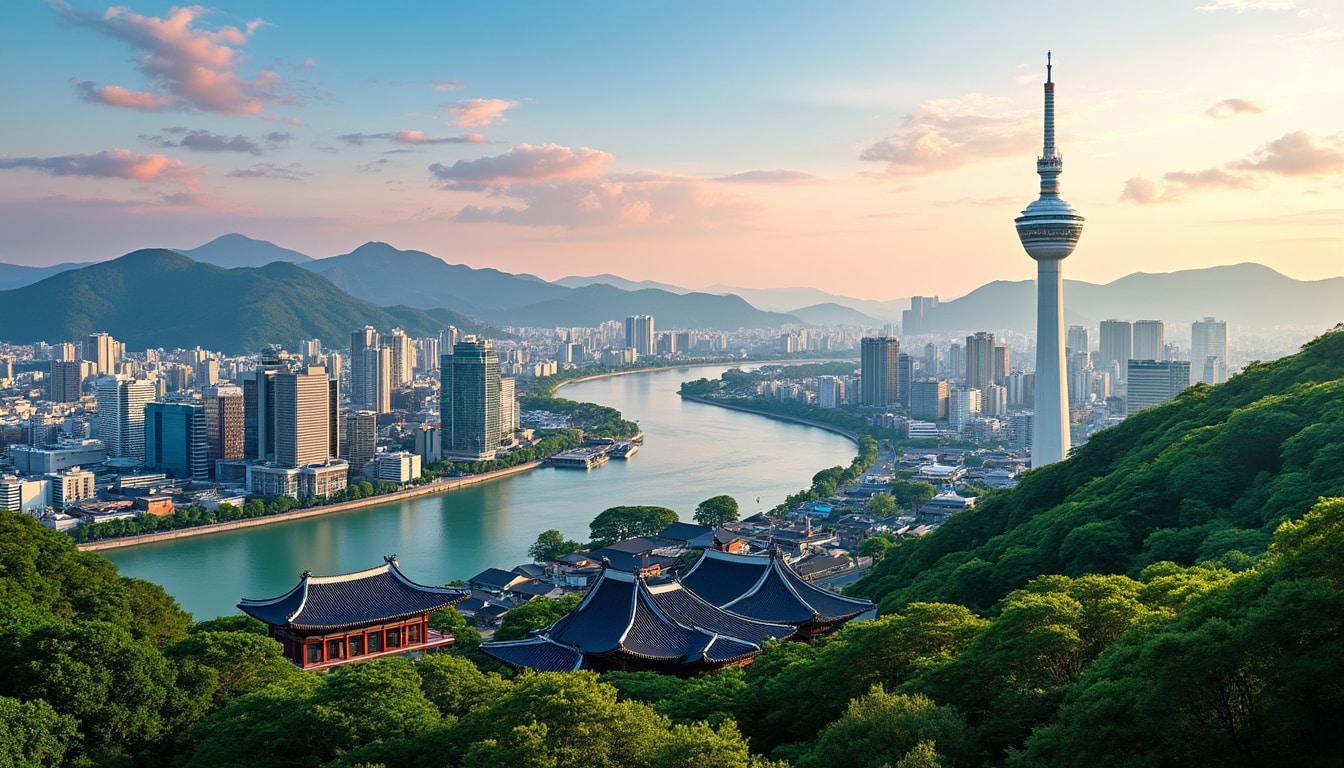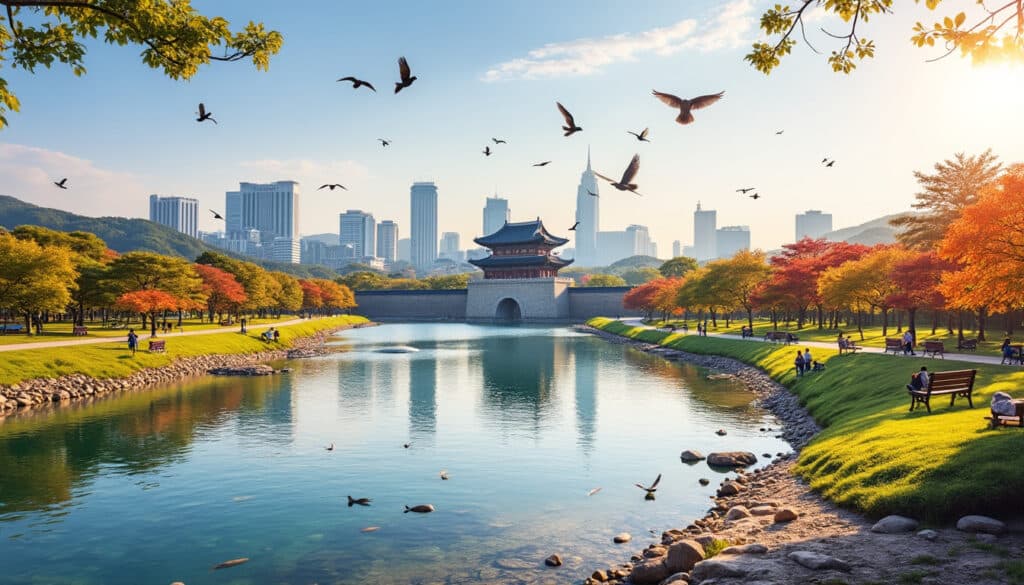Seoul, a city that seamlessly blends the old with the new, offers a unique geographical tapestry that is as diverse as it is fascinating. The bustling capital of South Korea is set against a backdrop of picturesque mountains, nestled beside the winding Han River, and adorned with a legacy that is both ancient and modern.
Seoul’s Mountainous Backdrop
Seoul, situated in the northwest part of South Korea, is enveloped by majestic mountains, lending it a natural grandeur rarely found in other world-class cities. Among these towering peaks, the most notable is Bukhansan National Park. This protected area is celebrated for its breathtaking views and rich biodiversity, making it a haven for both nature lovers and hikers.
Mountains like Bukhansan serve not only as a visual spectacle but also play a crucial role in the city’s ecosystem. They help regulate the climate, reduce pollution levels, and offer a refuge for flora and fauna. Bukhansan is particularly renowned for its granite peaks and lush landscapes, which stand in stark contrast to the urban sprawl below. Hikers venturing up its trails can expect to encounter a wide range of wildlife, including the Korean goral, a goat-like species native to the region.
Beyond its ecological significance, the mountains surrounding Seoul carry cultural and historical importance. Mountains such as Namsan offer panoramic views of the city and are home to significant structures like the Seoul Tower. Such landmarks not only symbolize the fusion of natural beauty and modern development but also serve as cultural touchstones for residents and tourists alike.
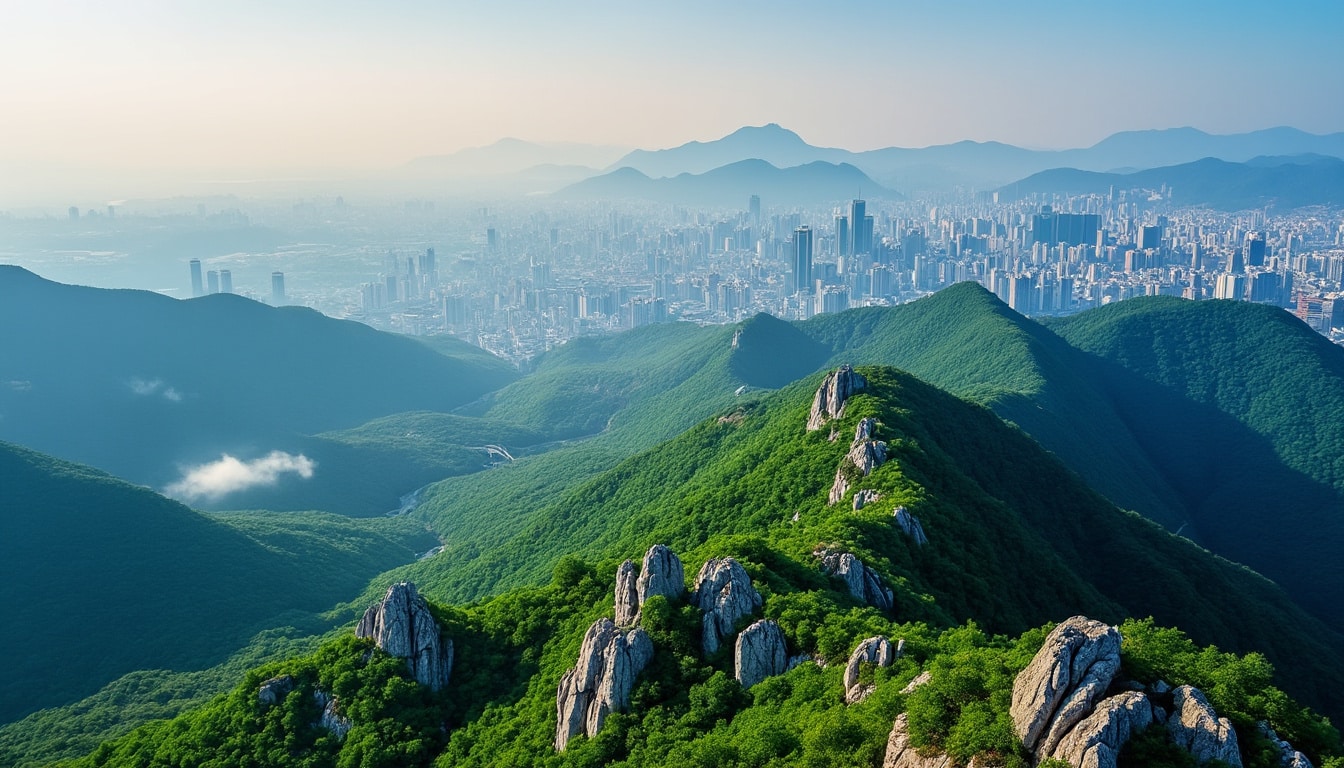
Exploring the Peaks
For those interested in exploring these geographical marvels, several trails and guided tours are available. These excursions provide insights into the geological history and cultural narratives of Seoul’s mountains. Adventure seekers can embark on day hikes, engaging with local guides who share stories about ancient fortresses hidden within the peaks, remnants of Korea’s storied past.
- 🏞️ Bukhansan: Ideal for day hikes, showcasing stunning vistas and historical sites.
- 🌄 Namsan: Offers accessible trails and the iconic Seoul Tower for panoramic views.
- ⛰️ Gwanaksan: Known for challenging trails and unique rock formations.
The mountainous terrain also plays a strategic role in Seoul’s urban planning. The presence of these natural barriers has influenced the city’s expansion, compelling urban developers to integrate green spaces within the urban grid. This harmonious blend of nature and cityscape not only enhances living conditions but also elevates Seoul’s appeal as a dynamic metropolis.
The Han River: Seoul’s Lifeline
The Han River, weaving gracefully through the heart of Seoul, has been an integral part of the city’s history and development. Serving as a geographical divide, it delineates the northern and southern sections of the city, each with its unique character and charm.
This mighty river has historically been a vital artery for trade and transport. In ancient times, it connected Seoul to neighboring regions, facilitating cultural exchange and economic growth. Today, the Han River symbolizes leisure and recreation, with its banks serving as parklands for locals and visitors to relax and enjoy.
Alongside its banks, one can find iconic spots such as the Cheonggyecheon Stream, a restored urban stream that offers a tranquil getaway amidst the city’s hustle and bustle. The development of parks and recreational facilities along the Han has transformed it into a vibrant epicenter for community activities, from musical festivals to annual firework displays.
| Feature | Description | Activities |
|---|---|---|
| 🌊 Han River | Main waterway through Seoul, historical trade route. | Boating, Cycling, Park Visits |
| 🌿 Cheonggyecheon Stream | Restored stream in downtown Seoul. | Walking, Picnicking, Events |
Moreover, the Han River serves as a key environmental resource for Seoul. It plays a crucial role in the city’s water supply and is a focal point for initiatives aimed at enhancing sustainability. Programs are in place to maintain the river’s health, ensuring it continues to support the diverse ecosystem that thrives within its habitat.
Seoul’s Urban Green Spaces
Seoul may be a bustling metropolis, but it is also home to a network of urban green spaces that offer respite from the city’s fast pace. These parks not only enhance the city’s beauty but also provide essential ecological services, helping to regulate temperature and improve air quality.
Among these verdant oases is Olympic Park, a vast area developed for the 1988 Summer Olympics. This sprawling park is a hub for recreational activities, featuring extensive paths for cycling and walking, as well as sculptures and art installations that celebrate Korea’s sporting achievements. Locals and tourists alike flock to Olympic Park for its serene lakes and meticulously manicured gardens, which provide a perfect escape from city life.
Namsan Mountain is another green jewel in the city’s crown. Often visited for its views from the Seoul Tower, Namsan is also beloved for its extensive walking paths. These trails lead visitors through forested areas and historical sites, offering a glimpse into Seoul’s past while providing a sanctuary of peace and quiet.
- 🏟️ Olympic Park: A legacy from the 1988 Olympics, popular for leisure and events.
- ⛩️ Namsan Mountain: Known for its scenic walks and Seoul Tower.
- 🪴 Dongdaemun Design Plaza: Combines art, culture, and green space.
The integration of green spaces throughout Seoul is a testament to the city’s commitment to sustainability. By maintaining these areas, Seoul provides its residents with high-quality living environments, promoting physical and mental well-being while preserving the natural heritage of the region.
Moreover, these spaces play a critical role in fostering community, as they host cultural and social events that bring people together. From traditional festivals in Namsangol Hanok Village to modern exhibitions at the Dongdaemun Design Plaza, Seoul’s parks and gardens are central to its vibrant culture.
The Historical Riverbanks of Seoul
Seoul’s history is inextricably linked to its waterways, which have played a pivotal role in shaping the city’s development over centuries. The Han River, while a modern-day recreational hub, carries with it stories from various eras, serving as a testament to Seoul’s resilience and adaptability.
The riverbanks are dotted with historical landmarks such as Gyeongbokgung Palace, which dates back to the Joseon Dynasty. This palace complex showcases traditional Korean architecture, offering insights into the artistic and cultural achievements of the era. The palace’s proximity to the river underscores its historical significance as a seat of power and governance.
Across the river, the area known as Gangnam represents the new Seoul, characterized by its futuristic architecture and vibrant nightlife. The juxtaposition of ancient and modern along the river highlights Seoul’s dynamic character, seamlessly blending history with innovation.
| Historical Site | Period | Key Features |
|---|---|---|
| 🏯 Gyeongbokgung Palace | Joseon Dynasty | Traditional Architecture, Museums |
| 🏢 Gangnam | Modern Era | Skyscrapers, Entertainment |
The riverbanks serve as a living museum, telling the story of Seoul’s transformation over time. From the days of ancient kingdoms to the vibrant cityscape of today, these areas reflect the city’s journey through history, embodying the spirit of progress and continuity.
Seoul’s Climate and Seasonal Changes
Seoul experiences four distinct seasons, each bringing its own charm and challenges to the city. The climate plays a crucial role in shaping the lifestyle and activities in Seoul, influencing everything from tourism to daily commuting.
Spring is a particularly enchanting time in Seoul, as cherry blossoms bloom across the city, painting the landscape in shades of pink and white. This season draws tourists from around the world, eager to partake in festivals and enjoy the mild weather. Popular locations for experiencing the blossoms include the banks of the Han River and the pathways of Namsan.
Summer in Seoul is characterized by its warmth and humidity, with the city’s proximity to the seas influencing its weather patterns. The Han River and its surrounding parks become popular retreats for city dwellers seeking relief from the heat, offering boating and outdoor activities.
- 🌸 Spring: Cherry blossoms, festivals, mild temperatures.
- ☀️ Summer: Warm, humid, perfect for water-based activities.
- 🍂 Autumn: Clear skies, ideal for hiking and outdoor events.
- ❄️ Winter: Cold, potential for snow, scenic views.
Autumn is often regarded as the best time to visit Seoul, with its cool temperatures and clear skies providing excellent conditions for exploring the city’s natural and historical sites. The foliage in the city’s parks and mountains transforms into a vibrant tapestry of reds, oranges, and yellows, creating stunning vistas.
Winter, though cold, presents opportunities for experiencing Seoul’s festive atmosphere, with events such as ice festivals and holiday markets drawing crowds. The snow-dusted cityscape, coupled with cozy cafes and street food vendors, provides a magical winter experience.
The interplay of seasons in Seoul adds a dynamic element to the city’s geographical features, offering varied experiences throughout the year. The city’s adaptability to these seasonal changes reflects its resilience and capacity for reinventing itself, ensuring that residents and visitors alike have countless reasons to explore and enjoy all that Seoul has to offer.
FAQ
- What makes Seoul’s geography unique?
Seoul’s geography is unique due to its combination of mountains, rivers, and urban landscapes, offering diverse natural and cultural experiences.
- How does Seoul’s climate affect its tourism?
The climate influences tourism through its distinct seasons, each offering different attractions, from spring cherry blossoms to winter festivals.
- What are popular outdoor activities in Seoul?
Popular activities include hiking in Bukhansan, cycling along the Han River, and exploring the gardens of Olympic Park.
- How does the Han River contribute to Seoul’s culture?
The Han River is central to Seoul’s cultural life, hosting events, recreational activities, and symbolizing the city’s historical and modern journey.
- Which season is best for visiting Seoul?
Autumn is often recommended for its mild weather and vibrant foliage, providing an excellent backdrop for exploring the city.
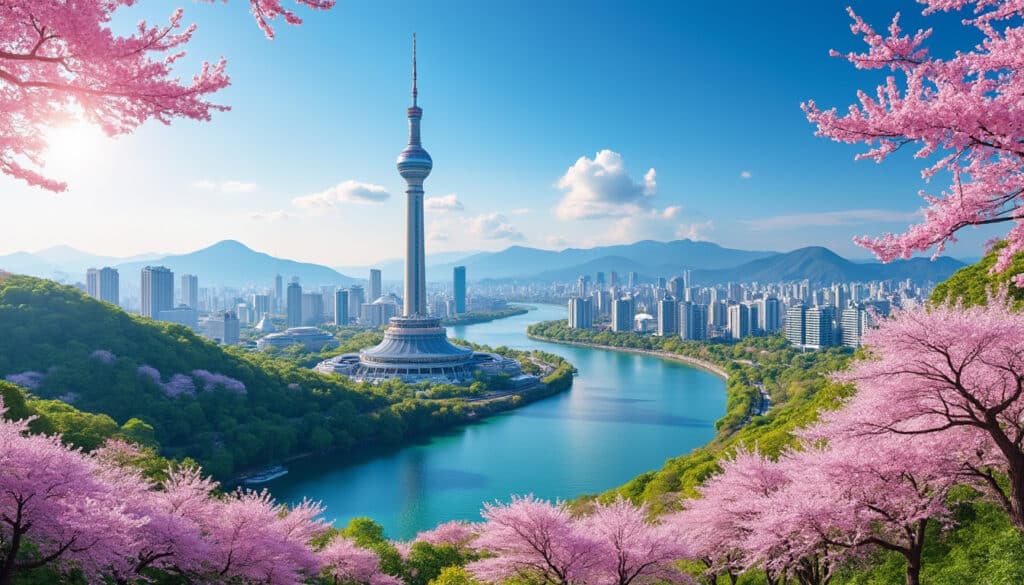
Seoul, the vibrant capital of South Korea, is a fascinating blend of modernity and tradition, nestled amidst a diverse and compelling natural landscape. Known for its bustling city life, Seoul offers more than just its skyscrapers and neon lights. The…
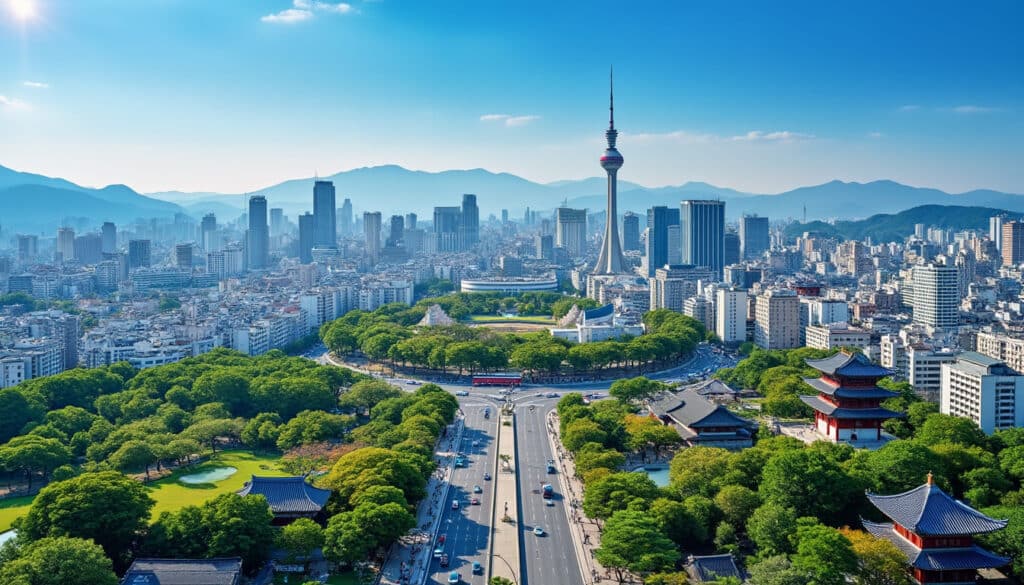
Location and coordinates of Seoul
Seoul, the vibrant capital city of South Korea, is a dynamic metropolis blending ancient traditions with cutting-edge technology. Strategically positioned in Northeast Asia, Seoul’s unique geographic location has played a pivotal role in shaping its development and influence throughout history.…
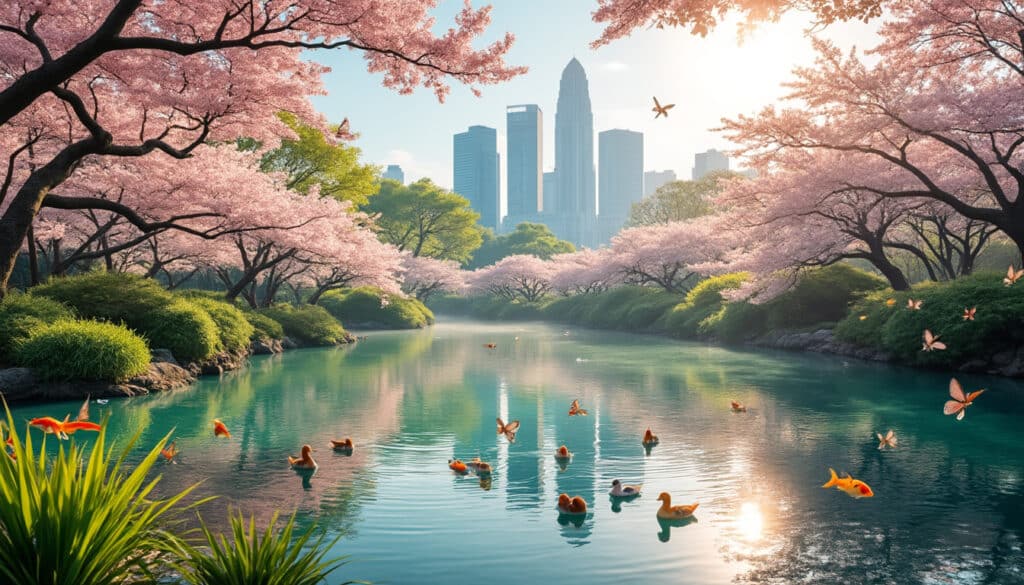
Seoul, a city renowned for its vibrant urban life and towering skyscrapers, also harbors a surprising natural beauty that invites both locals and visitors to take a refreshing step back from the bustling streets. Amidst the blend of modernity, you’ll…

